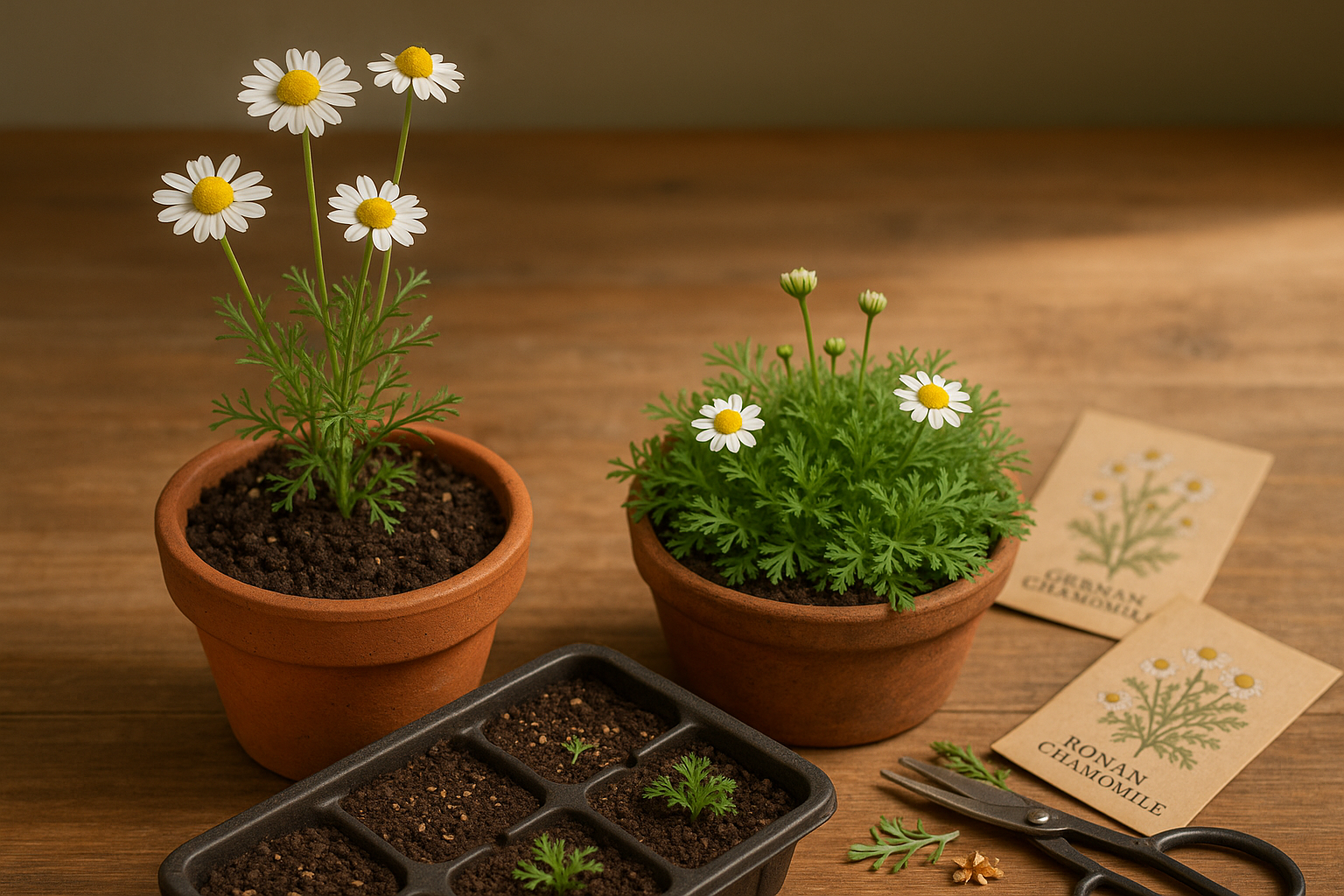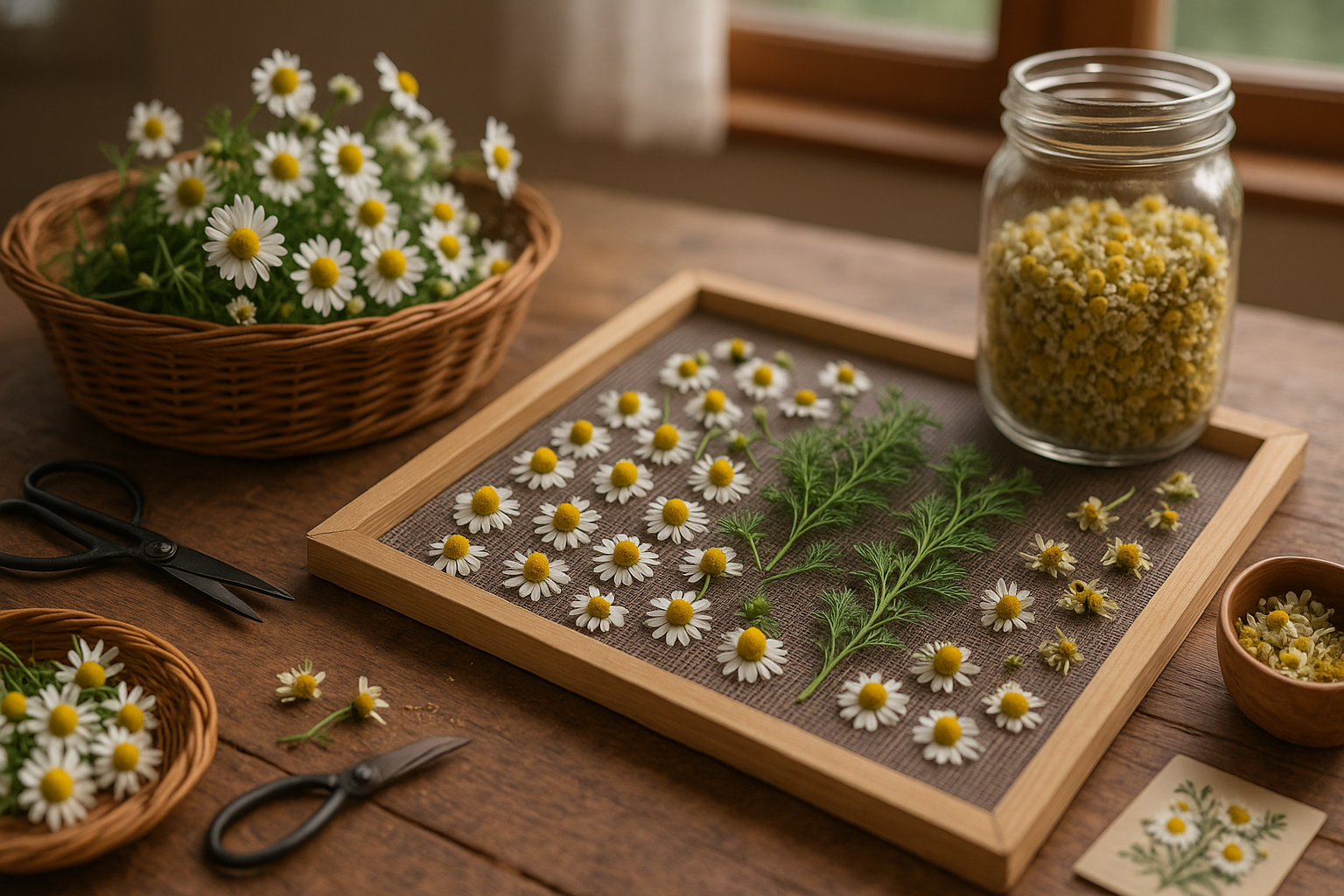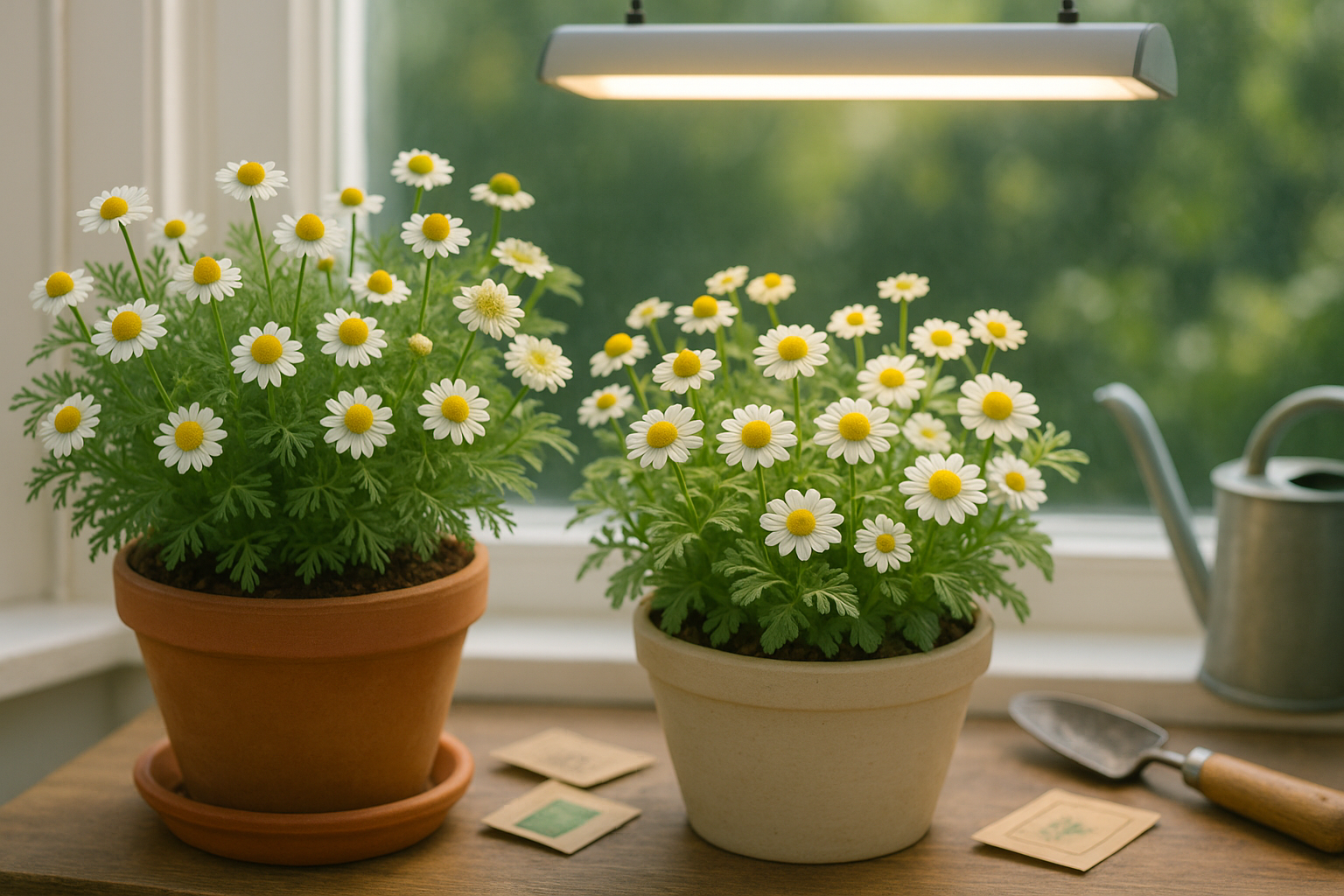Why Grow Chamomile Indoors?
Chamomile, a beloved herb with delicate, daisy-like flowers, comes in two main types: German chamomile (Matricaria chamomilla), an annual that grows tall, and Roman chamomile (Chamaemelum nobile), a low-growing perennial. Both varieties are cherished for their calming properties and are commonly used in herbal teas, soothing tinctures, and homemade skincare remedies.
Growing chamomile indoors means you’ll always have fresh blooms at your fingertips—perfect for brewing a cup of tea after a long day or mixing into natural remedies to ease stress and support sleep. Beyond their practical uses, chamomile plants release a gentle, apple-like fragrance that helps freshen your living space, making even small apartments feel more inviting. Their delicate white and yellow flowers also add a cheerful decorative touch to windowsills, kitchen counters, or shelves.
Indoor chamomile growing is especially ideal for apartment residents with limited or no outdoor space, beginners wanting a low-maintenance plant to start their gardening journey, and herbal enthusiasts looking to cultivate their own supply for holistic wellness. With just a sunny windowsill and occasional care, anyone can enjoy the convenience, beauty, and wellness benefits of fresh chamomile right at home.
Choosing the Right Chamomile Variety

When it comes to choosing the right chamomile for your indoor garden, it’s important to know the difference between German and Roman chamomile. German chamomile (Matricaria chamomilla) is an annual known for its tall, upright growth and abundant, daisy-like flowers with a sweet, apple-like scent. It can reach up to two feet in height, making it better suited for larger containers or spots with a bit more headroom, like sunny windowsills or balcony spaces. Its delicate, fragrant blooms are perfect for brewing soothing herbal teas and creating homemade skincare products.
In contrast, Roman chamomile (Chamaemelum nobile) is a low-growing perennial with a spreading, mat-forming habit that tops out around a foot tall. Its subtle, slightly bitter flavor makes it ideal for fragrant groundcovers in garden beds, but it also thrives in shallow pots or hanging baskets indoors—especially if you want trailing, decorative greenery. If you’re hoping for a long-term houseplant or ornamental accent, Roman chamomile’s perennial nature is a big plus.
For indoor success with either type, start with high-quality, certified organic seeds or robust seedlings from a trusted nursery. Inspect seedlings for vibrant green leaves, and avoid any that show signs of wilting or yellowing.
Keep in mind:
- German chamomile seeds are tiny—sow them on the surface and mist lightly to avoid washing them away.
- Roman chamomile seeds can be gently pressed into the soil.
- A bright, south-facing window provides the light they crave.
- Rotating the pots will help keep stems strong and upright.
Select the variety that fits your space and taste preferences, and you’ll be sipping homegrown chamomile tea in no time.
Light and Temperature Needs
Chamomile thrives best when it receives plenty of sunlight. If you’re growing it indoors, aim to provide at least 6 to 8 hours of direct sun per day. A south-facing window is usually your best bet, as it typically gets the most consistent, intense light. If a south-facing window isn’t an option, east or west windows can work, but you may need to supplement with artificial lighting—especially in winter or homes with limited sunlight.
For grow lights, look for full-spectrum LED or fluorescent bulbs. Keep them about 6 inches above the plant canopy and run them for up to 14 hours daily. This ensures your chamomile gets enough light energy to thrive, develop healthy foliage, and bloom.
Temperature also plays a crucial role in successful indoor chamomile cultivation. Ideally, keep the room between 65°F and 75°F (18°C to 24°C) during the day and make sure it doesn’t drop below 55°F (13°C) at night. Sudden drafts, proximity to heaters, or fluctuating temperatures can stress the plant, so choose a stable environment away from vents and radiators.
Good air circulation is another key factor—avoid cramming chamomile into stuffy corners or crowding it with other plants. An oscillating fan placed nearby on a low setting can help mimic a gentle breeze and prevent the development of mildew or fungal issues.
By offering chamomile the right amount of light, steady warmth, and plenty of fresh air, you create the perfect conditions for lush, productive growth—making it much easier to enjoy those fragrant blossoms in your tea or as a charming indoor accent.
Potting, Soil, and Watering Tips
Choosing the right pot and soil makes a world of difference when growing chamomile, whether you’re an experienced gardener or just starting out. First, opt for pots that are at least 6–8 inches deep with ample drainage holes at the bottom. Clay or terracotta pots are great choices—they’re porous and help prevent soil from staying soggy, reducing the risk of root rot.
If you prefer plastic pots, double-check that they have enough holes and never let water collect in a saucer underneath. Picking the correct soil is just as important; chamomile thrives in well-draining, sandy or loamy soil. You can use a high-quality commercial potting mix but boost drainage by blending in a handful of coarse sand or perlite. Avoid heavy garden soils or mixes intended for moisture-loving plants, since chamomile hates “wet feet.”
When it comes to watering, the key is moderation. Always check the top inch of soil before watering—if it feels dry, give your plant a thorough drink, letting excess water flow out of the bottom of the pot. If the soil is still damp, wait a day or two before checking again.
In hot, dry weather you may need to water two or three times a week, but be mindful; it’s far better to slightly underwater than to risk the sogginess that leads to root diseases. A good rule of thumb is to water early in the day, allowing the soil surface to dry out before nightfall.
Finally, observe your plant’s leaves: wilting can mean both under- or overwatering, but yellow, limp leaves are often a warning sign of root problems from too much moisture. By paying attention to your chamomile’s pot, soil, and watering routine, you’ll be well on your way to healthy, happy plants that thrive indoors or out.
Daily Care and Troubleshooting
Keeping your indoor plants healthy starts with a regular care routine. Aim to fertilize most houseplants every 4–6 weeks during spring and summer when growth is active, using a balanced, water-soluble fertilizer at half strength to avoid overfeeding. In the fall and winter, cut back or stop fertilizing since most plants rest.
Pruning is just as important: use clean scissors to snip off dead, yellowing, or damaged leaves, which helps redirect the plant’s energy to healthy growth. For bushier shapes, pinch back stem tips or trim overly long branches.
Monitor your plants’ overall health weekly—look for changes in leaf color, spots, webbing, or wilting, which might signal a problem.
Preventing Pests
Prevent pests like spider mites, aphids, and fungus gnats by wiping leaves with a damp cloth, keeping humidity consistent, and avoiding waterlogged soil. If you spot pests, isolate the plant, wash leaves thoroughly, and try neem oil or insecticidal soap as gentle first-line treatments.
Addressing Common Issues
- Leggy growth: Move your plant to a brighter location or rotate it so all sides receive sunlight evenly.
- Yellow leaves: Check for overwatering, poor drainage, or lack of nutrients—let soil dry between waterings and ensure pots have drainage holes.
- Poor blooming: This can result from too little light, infrequent feeding, or the plant being pot-bound. Try repotting in fresh soil, increasing exposure to indirect light, and following the recommended fertilizing schedule.
Good airflow, clean tools, and periodic plant inspections are your best defense against most issues. By integrating these habits, you’ll keep your indoor garden vibrant and resilient with minimal effort.
Harvesting and Using Fresh Chamomile

Harvesting chamomile flowers at the right time is key to enjoying their calming benefits for many months. For the richest flavor and continued blooming, pick the flowers in the morning after the dew has dried but before the midday sun gets hot, when the white petals are freshly open and the yellow centers are bright.
Gently pinch or snip the flower heads just above the leaves, taking only the open blooms and leaving the smaller buds to mature for the next harvest—this encourages the plant to keep producing more flowers throughout the season.
To dry your chamomile, spread the flower heads in a single layer on a clean screen or paper towel in a well-ventilated, shaded spot. They’ll be ready when the centers feel dry and slightly crisp, usually in about a week.
For easy storage, transfer the dried flowers to an airtight glass jar and stash them in a cool, dark cupboard to maintain their aroma and potency for up to a year.
Uses for Dried Chamomile
Dried chamomile is wonderfully versatile:
- Steep a spoonful in hot water for a soothing, naturally sweet tea.
- Add a handful to bathwater for a relaxing soak that’s gentle on the skin.
- Tuck some into homemade sachets, soaps, or candles for a fragrant, homemade touch.
Whether brewing, bathing, or crafting, a little prep ensures you have this gentle herb on hand whenever you need it.
